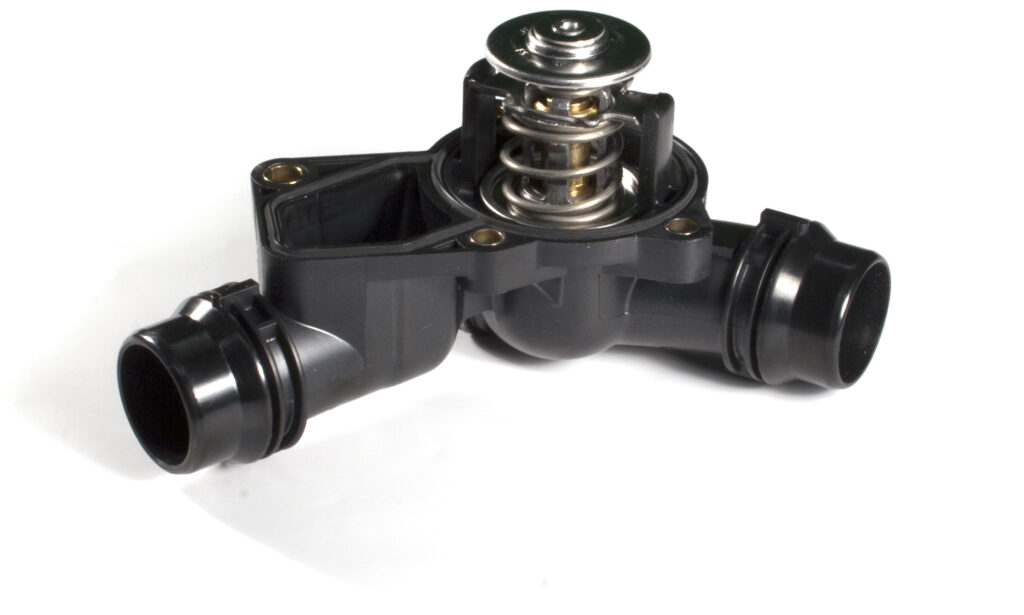The benefits of MAP-controlled thermostats
By Chris Holley, MACS Contributor
Over the last 100 years, thermostats have been a critical component of the engine’s cooling system. In the early 20th-century, Weston M. Fulton patented an evaporative bellows thermostat, and by 1934, Sergius Vernet developed the wax-pellet thermostat. Wax-pellet thermostats came in two configurations, the butterfly or the sleeve style.
Although several British car manufacturers used the bellow type until the 1960s, the wax pellet, specifically the sleeve, remains a simple yet effective component in the cooling system for late-model vehicles.
While many technicians may not realize it, thermostats have become more complex in the last two decades. Manufacturers have begun installing electronically controlled mapped (MAP) thermostats in production vehicles to increase engine efficiency. The MAP thermostats electrically heat the wax-pellet to adjust the thermostat to maximum opening when high vehicle speed, increased engine load, or a driver-activated performance (sport) mode is selected.

The thermostat operates conventionally with a MAP thermostat at low-to-medium engine load or moderate cruising speeds. However, the thermostat opens at a higher temperature (between 212-230°F), increasing the combustion process due to greater cylinder wall temperatures while lowering carbon monoxide and hydrocarbon emissions. In addition, because of this increased temperature, the fuel consumption drops as a result of reduced parasitic losses due to lower engine oil viscosity.
However, when the powertrain control module detects heightened engine load, increased vehicle speed or sport mode activation, a heating element in the thermostat is electrically activated. The heating of the wax pellet will quickly open the thermostat to its maximum position. As a result, the coolant temperature will drop to 180-194°F. A lower cooling system temperature improves the combustion chamber’s air density. Because of the denser air charge, the engine output increases during high-performance operating cycles, while the reduced temperature prevents engine overheating concerns.

With the information shared above, a customer driving a 2014 BMW 328i arrived at the college’s 2nd-year electrical lab reporting his illuminated check engine light. The customer had no complaints other than the light. The vehicle had just over 82K miles showing on the odometer. A student (Phil) assigned to the BMW performed a review with a scan tool, and a single code (P0597 – Thermostat Heater Control Circuit Open) was present.
In the service manual, there were only three steps to test the concern of the thermostat. The first was to visually inspect the wiring connection at the thermostat for proper installation or damage. Phil did not find any damage. The second test was performed with an ohmmeter at the thermostat’s terminals with the connector disconnected. The specification was 2-10 ohms, and the reading was open. The last step was to replace the thermostat if it was open.
The owner obtained a thermostat from the dealership, and Phil installed it. To compensate for coolant loss, Phil poured in BMW-approved coolant. Finally, to verify the repair, Phil cleared the code, test drove the vehicle and returned the completed repair order. Once again, the cooling system can quickly react to engine loads and vehicle speeds while maintaining the engine’s performance, efficiency and emissions compliance.
Hello, I have a 32 model 2018 440i conv. 6cyl turbo. The motor is overheating,I repaired the coolant leak, expansion tank, replaced the coolant temp sender, removed to visually inspect the water pump, which looked brand new so refitted it Removed the cover off the engine temp control module or unit, it’s the unit that has the lower radiator hose pipe adapted sandwiched between it and the engine block, it also looks fine , I couldn’t find info on how to test it. I could get the engine fan to operate at a high speed with my scan tool activation feature however when I had the car running with heater opened to hit the engine fan only operated at a very low speed and I could not bleed the system for air pockets properly. I had an extension on the water reservoir had heaps of bubbles continually surfacing with pockets of air bleeding out but then the engine would boil up instantly and pour out of bottle . I would wait a little while fill the water back up, run motor again and same thing would happen, just like a stuck closed thermostat. Head gasket check is clear and ok. Can someone please help out with any info.
With appreciation Peter
Hi Peter! Diagnosing mobile air conditioning systems can be complicated, perhaps a MACS member shop can help you! Here is a link to the MACS member shop locator on our website: https://macsmobileairclimate.org/find-a-service-shop/